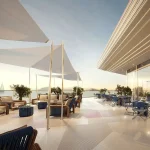
Amidst the impact of climate change, which has resulted in the increased threats of high-intensity storms and flooding seas, the Defence Advanced Research Projects Agency has offered financial assistance for the creation of artificial reefs that will be made of coral and oyster colonies.
This initiative, which is dubbed “Reefense” is intended to be able to absorb as much as ninety percent of the waves energy and is considered an eco-friendly solution instead of using the regular sea walls.
“If researchers can optimize these creatures to work in tandem with new artificial structures placed at sea, they believe the resulting barriers can take 90 percent of the energy out of waves. David Bushek, who directs the Haskin Shellfish Research Laboratory at Rutgers, swears he’s not hoping for a megastorm to come and show what his team’s unit is made of. But he’s not not hoping for one.” via Wired.
Mother Nature’s Solutions To Wave Energy
The artificial reefs have been specified to accommodate and allow the growth of oysters, which in the natural course of things create barriers that serve to dissipate waves. In particular, a prototype of these structures that has been installed at a military base in Florida has the capacity to cut down wave energy by 70% for these structures and this is expected to improve further as mature oysters grow and reinforce the structure.
To secure the long run goal of the reefs, DARPA is also working on breeding oysters that do not get infected and can also grow in tough environments able to build the reefs back up. This would also help during the rise in sea levels since it is certain that these barriers will be needed to protect shorelines and remain operational through the growth of the reefs.
Visionary Engineering and Natural Evolution Combined

These types of reefs use cutting edge technology along with the ability of the oysters to grow over time. While the static characteristic of seawalls enables them to do their primary purpose, these are not limited only to protecting the area against ocean waves but will also operate successfully even in case of the predicted climate changes.
If everything goes according to plan, this initiative has the potential to change the way in which policymakers think about design in the context of coastal military and civil infrastructure in extreme climate scenarios, promoting a blend of technology and green approaches.
You may find these pieces interesting:
- Disaster relief architecture: Mitigating environmental hazards and preparing for disasters
- Exploring 3D printed housing as a solution for post-disaster temporary shelters
- 3D-printed artificial reefs to restore coral ecosystems




















Leave a comment